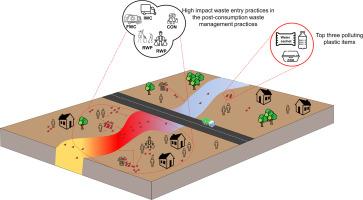Mapping plastic waste entry points into the riverine environment
Q2 Environmental Science
引用次数: 0
Abstract
Mismanaged plastic waste (MPW) is a major source of plastic pollution in rivers, particularly in regions with insufficient waste management infrastructure. Despite prior studies on MPW drivers, the entry points of MPW into riverine environments across the lifecycle of specific plastic items have not been assessed. This study addresses this gap by analyzing the lifecycle of the three most polluting plastic items, drinking water sachets, small bottles, and expanded polystyrene (EPS) food packaging in the Odaw catchment, located in Accra, Ghana to identify their critical entry points into the riverine environment. The Odaw is known for its high contribution to environmental plastic pollution due to the high anthropogenic activities, coupled with its inadequate waste management systems. Using a qualitative methodology, interviews and focus group discussions were conducted with 15 stakeholders involved in production, retail, consumption, waste management, and regulation across the plastic lifecycle. Data collected through audio recordings, were transcribed and analysed through inductive content analysis approach in ATLAS.ti. The findings reveal that all MPW entry points occur during post-consumption stages, with four of eight identified practices classified as high-impact. EPS packs was not recovered for recycling, bottles were exported overseas for recycling, and water sachets recovery faced challenges due to the low market prices and limited recycling capacity. This highlights the catchment’s limited recycling infrastructure. The study provides localized insights for targeted mitigation strategies and support targeted monitoring efforts. Furthermore, it offers a replicable methodological framework for regions with limited waste operations data, serving as a baseline for data-rich regions.

绘制塑料废物进入河流环境的入口点
管理不善的塑料废物是河流塑料污染的主要来源,特别是在废物管理基础设施不足的地区。尽管之前对MPW驱动因素进行了研究,但在特定塑料制品的整个生命周期中,MPW进入河流环境的切入点尚未得到评估。本研究通过分析位于加纳阿克拉的Odaw流域三种污染最严重的塑料制品的生命周期来解决这一差距,即饮用水袋、小瓶和膨胀聚苯乙烯(EPS)食品包装,以确定它们进入河流环境的关键切入点。由于人为活动频繁,再加上废物管理系统不足,奥达乌对环境塑料污染的贡献很大。采用定性方法,与涉及塑料生命周期中生产、零售、消费、废物管理和监管的15个利益相关者进行了访谈和焦点小组讨论。通过录音收集的数据,通过ATLAS.ti的归纳内容分析方法进行转录和分析。研究结果显示,所有MPW进入点都发生在消费后阶段,8种确定的做法中有4种被归类为高影响。EPS包装没有回收再循环,瓶子出口到海外再循环,由于市场价格低和回收能力有限,水袋的回收面临挑战。这凸显了集水区有限的回收基础设施。该研究为有针对性的缓解战略提供了本地化见解,并为有针对性的监测工作提供了支持。此外,它为废物处理数据有限的区域提供了一个可复制的方法框架,作为数据丰富区域的基线。
本文章由计算机程序翻译,如有差异,请以英文原文为准。
求助全文
约1分钟内获得全文
求助全文
来源期刊

Environmental Challenges
Environmental Science-Environmental Engineering
CiteScore
8.00
自引率
0.00%
发文量
249
审稿时长
8 weeks
 求助内容:
求助内容: 应助结果提醒方式:
应助结果提醒方式:


